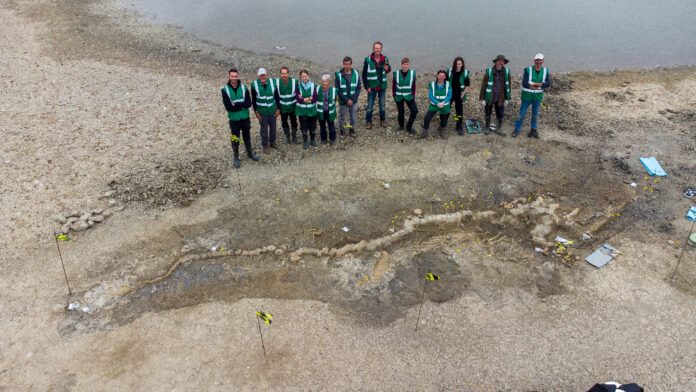The fossilised remains of Britain’s largest ichthyosaur, colloquially known as a ‘Sea Dragon’, have been discovered at the Rutland Water Nature Reserve, owned and run by Anglian Water. It is the biggest and most complete skeleton of its kind found to date in the UK and is also thought to be the first ichthyosaur of its species found in the country.
The ichthyosaur was discovered by Joe Davis, Conservation Team Leader at Leicestershire and Rutland Wildlife Trust, who operates the nature reserve in partnership with the water company, during the routine draining and maintenance of a lagoon at Rutland Water in January 2021.
Joe Davis, who discovered the remains, said: “The find has been absolutely fascinating and a real career highlight, it’s great to learn so much from the discovery and to think that this amazing creature was once swimming in seas above us and now once again Rutland Water is a haven for wetland wildlife albeit a little smaller!”
Dr Dean Lomax, a palaeontologist and a Visiting Scientist at The University of Manchester, who has studied thousands of ichthyosaurs and named five new species, said: “It was an honour to lead the excavation and unearth this Jurassic giant from its ancient rocky tomb. Britain is the birthplace of ichthyosaurs – their fossils have been unearthed here for over 200 years, with the first finds to be recognized by science dating back to Mary Anning and her discoveries along the Jurassic Coast.
“Not only is it the largest ichthyosaur skeleton ever found in Britain, but it is also the most complete skeleton of a large prehistoric reptile ever discovered in the UK. And yes, that includes dinosaurs!”
The huge skeleton was carefully excavated in August and September 2021 by a team of expert palaeontologists assembled from around the UK, in partnership with Anglian Water, Rutland County Council and the Leicestershire and Rutland Wildlife Trust.
The excavation was led by world-leading ichthyosaur expert Dr Dean Lomax and specialist palaeontological conservator Nigel Larkin, along with marine reptile specialist Dr Mark Evans and vertebrate palaeontologist Dr Emma Nicholls from the Horniman Museum who combined their curatorial expertise to record the site. The team was supported by volunteers with experience in excavating fossil marine reptiles, including members of the local Peterborough Geological and Palaeontological Group.
Often mistaken for ‘swimming dinosaurs’, ichthyosaurs were a highly successful group of marine reptiles that became extinct about 90 million years ago. This new specimen is approximately 180 million years old and, with a skeleton measuring at least 10 metres in length and a skull weighing approximately one tonne, it is the most complete large ichthyosaur ever found in Britain.
Dr Mark Evans of the British Antarctic Survey and a Visiting Fellow at the University of Leicester said: “I’ve been studying the Jurassic fossil reptiles of Rutland and Leicestershire for over twenty years. When I first saw the initial exposure of the specimen with Joe Davis I could tell that it was the largest ichthyosaur known from either county. However, it was only after our exploratory dig that we realised that it was practically complete to the tip of the tail. In the 1970’s, when Rutland Water was being constructed, two partial, but much smaller ichthyosaur skeletons were found, so finding another of these Jurassic marine reptiles was not totally unexpected, but the size of the new find was a total surprise.”
The location of the discovery in landlocked Rutland also piqued the team’s interest. In the UK, Early Jurassic rocks stretch across the country from Yorkshire to Dorset, and most ichthyosaur discoveries have been made along coastlines. Historically, major fossil finds were made at inland locations through quarrying and the creation of new roads but such finds are incredibly rare nowadays, making this new find even luckier.
Dr Evans added: “Rutland’s motto, “Multum in Parvo”, translates as “Much in Little” so it is fitting that we’ve found Britain’s largest ichthyosaur skeleton in England’s smallest county. It’s a highly significant discovery both nationally and internationally but also of huge importance to the people of Rutland and the surrounding area. If our identification of the ichthyosaur is correct, as a species called Temnodontosaurus trigonodon, this will provide new details on the geographic range of the species as it hasn’t been confirmed from the UK before.”
Nigel Larkin, specialist palaeontological conservator and Visiting Research Fellow at Reading University, said: “The block containing the massive 2m-long skull weighs just under a tonne (comprising the fossil, the Jurassic clay in which it lies, and the encasing plaster of Paris and wooden splints). The block containing the main body section weighs about a tonne and a half. It’s not often you are responsible for safely lifting a very important but very fragile fossil weighing that much. It is a responsibility, but I love a challenge.”
Of the few large ichthyosaurs discovered in the UK, those collected historically have poorly recorded information, with details of where they were found and their age often completely unknown. This makes the new discovery particularly important. As part of the team, Dr Ian Boomer from the University of Birmingham took samples of the Jurassic clay surrounding the ichthyosaur and discovered microscopic fossils which have helped to pinpoint the exact layer the ichthyosaur came from and determine the age as between 181.5 and 182 million years old.







